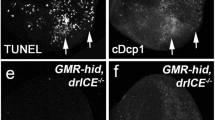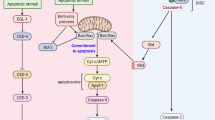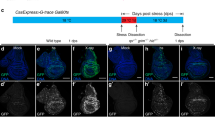Abstract
We previously described two human DnaJ proteins, hTid-1L and hTid-1S, which are derived from alternative splicing of the TID1 gene, the human homologue of the Drosophila tumor suppressor lethal(2) tumorous imaginal discs, and showed that hTid-1L promoted while hTid-1S antagonized apoptosis. There are two subsets of helper T cells, Th1 and Th2, of which Th2 cells are significantly less prone to apoptosis induced by stimulation through the T-cell receptor. This apoptotic process is known as activation-induced cell death (AICD). The molecular basis for the differential susceptibility of Th1 and Th2 cells to AICD is not known. Here we show that the antiapoptotic variant, Tid-1S, is selectively induced in murine Th2 cells following activation. Expression of a dominant-negative mutant of hTid-1S in a Th2 cell line strikingly enhanced activation of caspase 3 in response to CD3 stimulation, and caused the cells to become sensitive to AICD. Hence, the accumulation of Tid-1S in Th2 cells following activation represents a novel mechanism that may contribute to the induction of apoptosis resistance during the activation of Th2 cells.
This is a preview of subscription content, access via your institution
Access options
Subscribe to this journal
Receive 50 print issues and online access
$259.00 per year
only $5.18 per issue
Buy this article
- Purchase on Springer Link
- Instant access to full article PDF
Prices may be subject to local taxes which are calculated during checkout




Similar content being viewed by others
References
Agarwal S and Rao A . (1998). Immunity, 9, 765–775.
Aramburu J, Yaffe MB, Lopez-Rodriguez C, Cantley LC, Hogan PG and Rao A . (1999). Science, 285, 2129–2133.
Barkett M and Gilmore TD . (1999). Oncogene, 18, 6910–6924.
Baumann S, Krueger A, Kirchhoff S and Krammer PH . (2002). Curr. Mol. Med., 2, 257–272.
Caplan AJ, Cyr DM and Douglas MG . (1993). Mol. Biol. Cell, 4, 555–563.
Carter LL, Zhang X, Dubey C, Rogers P, Tsui L and Swain SL . (1998). J. Immunother., 21, 181–187.
Cheng H, Cenciarelli C, Shao Z, Vidal M, Parks WP, Pagano M and Cheng-Mayer C . (2001). Curr. Biol., 11, 1771–1775.
Cyr DM, Langer T and Douglas MG . (1994). Trends Biochem. Sci., 19, 176–181.
Eom CY and Lehman IR . (2002). Proc. Natl. Acad. Sci. USA, 99, 1894–1898.
Green DR and Scott DW . (1994). Curr. Opin. Immunol., 6, 476–487.
Ju ST, Panka DJ, Cui H, Ettinger R, el-Khatib M, Sherr DH, Stanger BZ and Marshak-Rothstein A . (1995). Nature, 373, 444–448.
Kaye J, Porcelli S, Tite J, Jones B and Janeway Jr CA . (1983). J. Exp. Med., 158, 836–856.
Kirchhoff S, Muller WW, Krueger A, Schmitz I and Krammer PH . (2000). J. Immunol., 165, 6293–6300.
Kirchhoff S, Sebens T, Baumann S, Krueger A, Zawatzky R, Li-Weber M, Meinl E, Neipel F, Fleckenstein B and Krammer PH . (2002). J. Immunol., 168, 1226–1234.
Kurzik-Dumke U, Debes A, Kaymer M and Dienes P . (1998). Cell Stress Chaperones, 3, 12–27.
Kurzik-Dumke U, Gundacker D, Renthrop M and Gateff E . (1995). Dev. Genet., 16, 64–76.
Kurzik-Dumke U, Phannavong B, Gundacker D and Gateff E . (1992). Differentiation, 51, 91–104.
Li-Weber M, Giaisi M, Baumann S, Treiber MK and Krammer PH . (2002a). Cell Death Differ., 9, 1256–1265.
Li-Weber M and Krammer PH . (2002). Cell Death Differ., 9, 101–103.
Li-Weber M, Weigand MA, Giaisi M, Suss D, Treiber MK, Baumann S, Ritsou E, Breitkreutz R and Krammer PH . (2002b). J. Clin. Invest., 110, 681–690.
Lohman BL and Welsh RM . (1998). J. Virol., 72, 7815–7821.
O’Garra A and Murphy K . (1994). Curr. Opin. Immunol., 6, 458–466.
Rao A, Faas SJ and Cantor H . (1984). J. Exp. Med., 159, 479–494.
Sarkar S, Pollack BP, Lin KT, Kotenko SV, Cook JR, Lewis A and Pestka S . (2001). J. Biol. Chem., 25, 49034–49042.
Sasaki S, Nakamura T, Arakawa H, Mori M, Watanabe T, Nagawa H and Croce CM . (2002). Oncogene, 21, 5024–5030.
Schilling B, De-Medina T, Syken J, Vidal M and Munger K . (1998). Virology, 247, 74–85.
Seder RA and Paul WE . (1994). Annu. Rev. Immunol., 12, 635–673.
Silver PA and Way JC . (1993). Cell, 74, 5–6.
Strasser A, Harris AW, Huang DC, Krammer PH and Cory S . (1995). EMBO. J., 14, 6136–6147.
Sullivan CS and Pipas JM . (2002). Microbiol. Mol. Biol. Rev., 66, 179–202.
Swain SL, Bradley LM, Croft M, Tonkonogy S, Atkins G, Weinberg AD, Duncan DD, Hedrick SM, Dutton RW and Huston G . (1991). Immunol. Rev., 123, 115–144.
Syken J, De-Medina T and Munger K . (1999). Proc. Natl. Acad. Sci. USA, 96, 8499–8504.
Trentin GA, Yin X, Tahir S, Lhotak S, Farhang-Fallah J, Li Y and Rozakis-Adcock M . (2001). J. Biol. Chem., 276, 13087–13095.
Tsai J and Douglas MG . (1996). J. Biol. Chem., 271, 9347–9354.
Van Parijs L, Ibraghimov A and Abbas AK . (1996). Immunity, 4, 321–328.
Van Parijs L, Refaeli Y, Abbas AK and Baltimore D . (1999). Immunity, 11, 763–770.
Varadhachary AS, Perdow SN, Hu C, Ramanarayanan M and Salgame P . (1997). Proc. Natl. Acad. Sci. USA, 94, 5778–5783.
Varadhachary AS, Peter ME, Perdow SN, Krammer PH and Salgame P . (1999). J. Immunol., 163, 4772–4779.
Wall D, Zylicz M and Georgopoulos C . (1994). J. Biol. Chem., 269, 5446–5451.
Yin X and Rozakis-Adcock M . (2001). Gene, 278, 201–210.
Zhang X, Brunner T, Carter L, Dutton RW, Rogers P, Bradley L, Sato T, Reed JC, Green D and Swain SL . (1997). J. Exp. Med., 185, 1837–1849.
Acknowledgements
We thank Drs Susanne J Szabo, Estelle Bettelli, Laurie Glimcher, Vijay Kuchroo, Padmini Salgame, and Sara Abramson-Leeman for their generous gifts of T helper cell lines, Dr Hidde Ploegh for his critical comments on the manuscript, John Daniel and other members of the Münger lab for their support and suggestions, and Miranda Grace for excellent technical assistance. We also acknowledge the helpful comments of the anonymous reviewers of this manuscript. This work was supported by a grant from the Collaborative Research Program between Harvard Medical School and Hoechst Marrion Roussel as well as grants from the NIH. JS is a Ryan Fellow, SA was a predoctoral fellow of the Howard Hughes Medical Institute.
Author information
Authors and Affiliations
Corresponding author
Rights and permissions
About this article
Cite this article
Syken, J., Macian, F., Agarwal, S. et al. TID1, a mammalian homologue of the drosophila tumor suppressor lethal(2) tumorous imaginal discs, regulates activation-induced cell death in Th2 cells. Oncogene 22, 4636–4641 (2003). https://doi.org/10.1038/sj.onc.1206569
Received:
Revised:
Accepted:
Published:
Issue Date:
DOI: https://doi.org/10.1038/sj.onc.1206569
Keywords
This article is cited by
-
hTID-1 defines a novel regulator of c-Met Receptor signaling in renal cell carcinomas
Oncogene (2011)
-
Multi-faceted role of HSP40 in cancer
Clinical & Experimental Metastasis (2009)
-
Large isoform of MRJ (DNAJB6) reduces malignant activity of breast cancer
Breast Cancer Research (2008)
-
Molecular determinants of caste differentiation in the highly eusocial honeybee Apis mellifera
BMC Developmental Biology (2007)
-
Expression of EIF3-p48/INT6, TID1 and Patched in cancer, a profiling of multiple tumor types and correlation of expression
Journal of Biomedical Science (2007)



